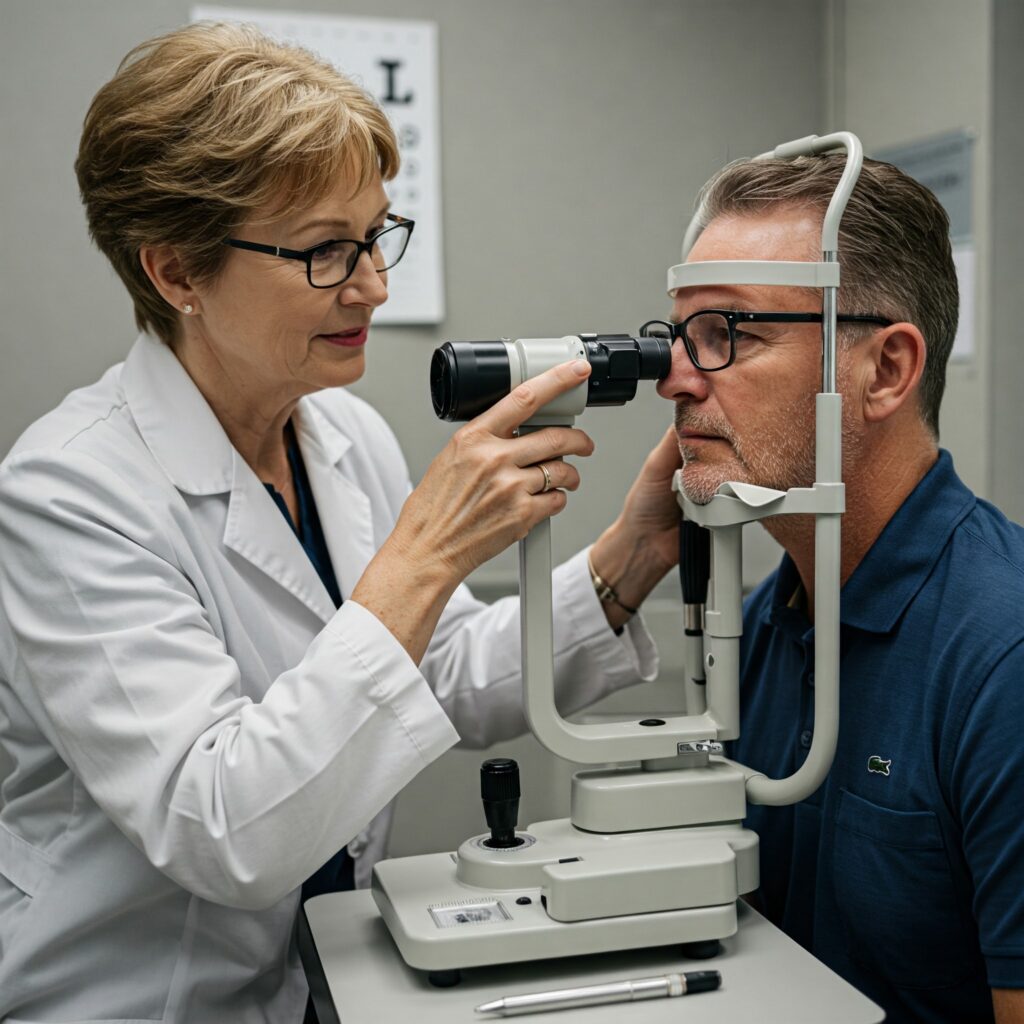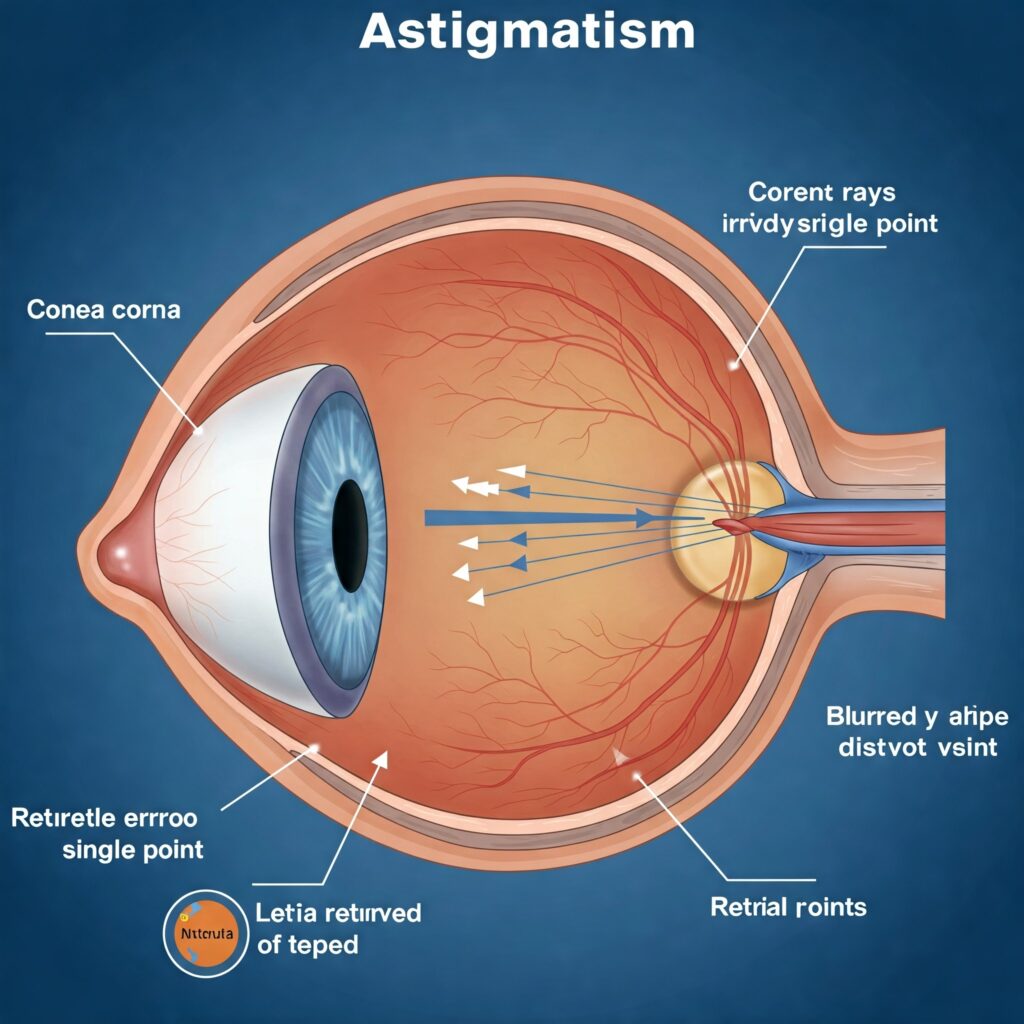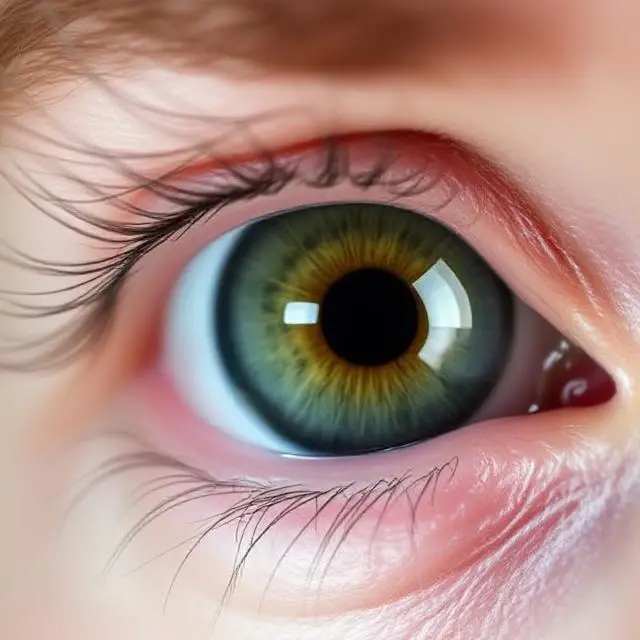When it comes to vision problems, astigmatism and myopia are two of the most common conditions people experience. While both can cause blurry vision, they are fundamentally different in terms of causes, symptoms, and treatment options. Understanding the differences between astigmatism vs myopia is crucial for proper diagnosis and effective management of these eye conditions.
In this blog post, we’ll explore the 7 major key differences between astigmatism vs myopia, helping you gain a clearer understanding of each condition and how they affect your vision.

Definition and Nature of the Conditions
Astigmatism
Astigmatism is a refractive error caused by an irregularly shaped cornea or lens. Instead of being perfectly round like a basketball, the cornea or lens is shaped more like a football. This irregularity causes light to focus on multiple points in the eye, leading to blurred or distorted vision at all distances.
Myopia
Myopia, commonly known as nearsightedness, is a condition where the eyeball is slightly longer than normal or the cornea is too curved. This causes light to focus in front of the retina instead of directly on it, making distant objects appear blurry while close objects remain clear.
Key Difference: Astigmatism is caused by an irregularly shaped cornea or lens, while myopia is caused by the elongation of the eyeball or excessive curvature of the cornea.

Symptoms and How They Affect Vision
Astigmatism
People with astigmatism often experience:
- Blurred or distorted vision at all distances.
- Difficulty seeing fine details, both up close and far away.
- Eye strain or discomfort, especially after prolonged focus.
- Headaches due to the extra effort required to focus.
Myopia
Individuals with myopia typically experience:
- Clear vision when looking at close objects.
- Blurry vision when viewing distant objects, such as road signs or chalkboards.
- Squinting to see distant objects more clearly.
- Eye strain or fatigue, particularly after activities like driving or watching TV.
Key Difference: Astigmatism causes blurred vision at all distances, while myopia primarily affects distance vision.
Causes and Risk Factors
Astigmatism
Astigmatism is often hereditary and present from birth. However, it can also develop later in life due to:
- Eye injuries or surgeries that alter the shape of the cornea.
- Keratoconus, a condition where the cornea thins and bulges into a cone shape.
- Scarring or thinning of the cornea.
Myopia
Myopia is also influenced by genetics but can be exacerbated by environmental factors such as:
- Prolonged close-up work, like reading or using digital devices.
- Limited time spent outdoors, especially during childhood.
- Certain health conditions, such as diabetes.
Key Difference: Astigmatism vs myopia While both conditions have genetic links, myopia is more influenced by environmental factors compared to astigmatism.
Diagnosis Process
Astigmatism
Astigmatism vs myopia, Astigmatism is diagnosed through a comprehensive eye exam, which may include:
- A visual acuity test to measure how well you can see at various distances.
- A keratometry test to assess the curvature of the cornea.
- A refraction test to determine the lens power needed to correct your vision.

Myopia
Myopia is also diagnosed during an eye exam, with specific tests such as:
- A visual acuity test to check your ability to see distant objects.
- A retinoscopy to measure how light reflects off your retina.
- A phoropter test to determine the correct prescription for glasses or contact lenses.
Key Difference: Astigmatism vs myopia While the diagnostic tools are similar, the focus for astigmatism is on corneal shape, whereas for myopia, it’s on the eye’s ability to focus light.
Treatment Options
Astigmatism
Treatment options for astigmatism include:
- Prescription glasses or toric contact lenses to correct the irregular curvature.
- Refractive surgery, such as LASIK or PRK, to reshape the cornea.
- Orthokeratology (Ortho-K), which uses specially designed contact lenses to temporarily reshape the cornea.
Myopia
Myopia can be managed with:
- Prescription glasses or standard contact lenses to improve distance vision.
- Refractive surgery, like LASIK or SMILE, to reshape the cornea.
- Multifocal contact lenses or atropine eye drops to slow progression in children.
Key Difference: While both conditions astigmatism vs myopia can be treated with glasses, contact lenses, and surgery, astigmatism often requires specialized lenses (toric) to address the irregular corneal shape.

Impact on Daily Life
Astigmatism
Astigmatism can make everyday tasks challenging, such as:
- Reading small print or working on a computer for extended periods.
- Driving at night due to glare or halos around lights.
- Playing sports that require sharp distance vision.
Myopia
Astigmatism vs Myopia, Myopia primarily affects activities that require clear distance vision, such as:
- Watching TV or movies in a theater.
- Recognizing faces or objects from afar.
- Participating in outdoor sports like soccer or baseball.
Key Difference: Astigmatism vs myopia, astigmatism affects both near and far vision, while myopia mainly impacts distance-related activities.
Long-Term Progression and Complications
Astigmatism
Astigmatism typically remains stable over time but can worsen due to:
- Eye injuries or surgeries.
- Conditions like keratoconus.
- Aging, which can alter the shape of the cornea.
Myopia
Myopia often progresses during childhood and adolescence, potentially leading to:
- High myopia, which increases the risk of serious eye conditions like retinal detachment, glaucoma, or cataracts.
- Greater dependence on corrective lenses.
Key Difference: Myopia has a higher likelihood of progression and associated complications compared to astigmatism.
Astigmatism vs Myopia – Knowing the Difference Matters
Understanding the key differences between astigmatism vs myopia is essential for maintaining healthy vision and seeking the right treatment. While both conditions can cause blurry vision, their underlying causes, symptoms, and management strategies differ significantly.
If you suspect you have either condition, schedule an eye exam with an optometrist or ophthalmologist. Early diagnosis and proper correction can help you enjoy clearer vision and a better quality of life.
By staying informed about astigmatism vs myopia, you can take proactive steps to protect your eyes and ensure optimal visual health for years to come.
Which is worse: astigmatism or myopia?
Neither condition is inherently “worse.” Astigmatism causes blurred vision at all distances, while myopia primarily affects distance vision. The severity depends on the individual case and how it impacts daily life.
Can astigmatism go away on its own?
No, astigmatism does not go away on its own. However, it can be effectively managed with glasses, contact lenses, or surgery.
Does myopia get worse with age?
Myopia often progresses during childhood and adolescence but typically stabilizes in early adulthood. However, high myopia can increase the risk of other eye problems later in life.
